
Francis I, was Duke of Brittany, Count of Montfort and titular Earl of Richmond, from 29 August 1442 to his death. He was born in Vannes, the son of John V, Duke of Brittany and Joan of France, the daughter of King Charles VI of France.

Books of hours are Christian prayer books, which were used to pray the canonical hours. The use of a book of hours was especially popular in the Middle Ages, and as a result, they are the most common type of surviving medieval illuminated manuscript. Like every manuscript, each manuscript book of hours is unique in one way or another, but most contain a similar collection of texts, prayers and psalms, often with appropriate decorations, for Christian devotion. Illumination or decoration is minimal in many examples, often restricted to decorated capital letters at the start of psalms and other prayers, but books made for wealthy patrons may be extremely lavish, with full-page miniatures. These illustrations would combine picturesque scenes of country life with sacred images.
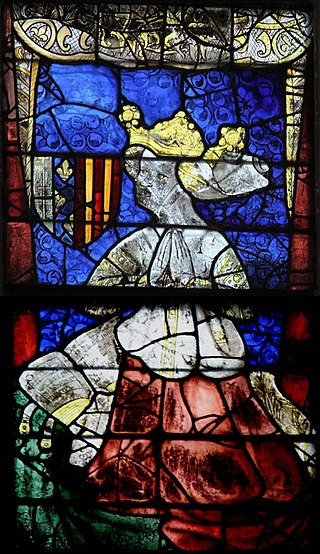
Yolande of Aragon was Duchess of Anjou and Countess of Provence by marriage, who acted as regent of Provence during the minority of her son. Yolande played a crucial role in the struggles between France and England, influencing events such as the financing of Joan of Arc's army in 1429 that helped tip the balance in favour of the French. She was also known as Yolanda de Aragón and Violant d'Aragó. Tradition holds that she commissioned the famous Rohan Hours.

Joan of France, Duchess of Bourbon, also known as Joan of Valois, was the seventh child and fourth daughter of Charles VII of France and Marie of Anjou. She was the original owner of the book of hours of Joan of France, now held in the Bibliothèque nationale de France, which is classified as a national treasure of France.

The Hours of Jeanne d'Evreux is an illuminated book of hours in the Gothic style. According to the usual account, it was created between 1324 and 1328 by Jean Pucelle for Jeanne d'Evreux, the third wife of Charles IV of France. It was sold in 1954 to the Metropolitan Museum of Art in New York where it is now part of the collection held at The Cloisters, and usually on display.

Isabella Stewart, was a Scottish princess who became Duchess of Brittany by marriage to Francis I of Brittany. Also known as Isabel, she was the second daughter of James I of Scotland and Joan Beaufort.
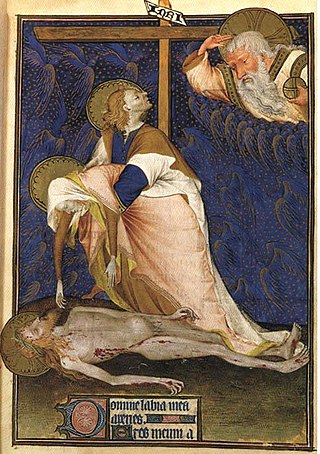
The Grandes Heures de Rohan is an illuminated manuscript book of hours, painted by the anonymous artist known as the Rohan Master, probably between 1418 and 1425, in the Gothic style. It contains the usual offices, prayers and litanies in Latin, along with supplemental texts, decorated with 11 full page, 54 half page, and 227 small miniatures, decorated with tempera paints and gold leaf. The book margins are decorated with Old Testament miniatures with captions in Old French, in the style of a Bible moralisée. The full page illuminations are renowned for the highly emotional and dramatic portrayal of the agonies of Christ and the grief of the Virgin. According to Millard Meiss, "The Rohan Master cared less about what people do than what they feel. Whereas his great predecessors excelled in the description of the novel aspects of the natural world, he explored the realm of human feeling." Meiss concludes that the Rohan Master was the "greatest expressionist in 15th century France." The manuscript is currently housed in the Bibliothèque Nationale, Paris, France.

Jeanne de Laval, was the second wife and titular Queen consort of René I of Anjou, King of Naples, Sicily, titular King of Jerusalem, Aragon, and Majorca; Duke of Anjou, Bar, and Lorraine; and Count of Provence and Piedmont.

Margaret of Brittany was a duchess consort of Brittany. She was the elder of the two daughters of Francis I, Duke of Brittany, by his second wife, Isabella of Scotland.
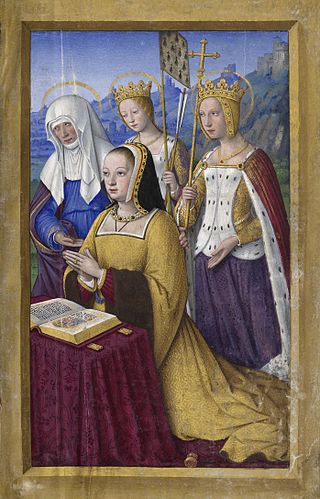
The Grandes Heures of Anne of Brittany is a book of hours, commissioned by Anne of Brittany, Queen of France to two kings in succession, and illuminated in Tours or perhaps Paris by Jean Bourdichon between 1503 and 1508. It has been described by John Harthan as "one of the most magnificent Books of Hours ever made", and is now in the Bibliothèque nationale de France, catalogued as Ms lat. 9474. It has 49 full-page miniatures in a Renaissance style, and more than 300 pages have large borders illustrated with a careful depiction of, usually, a single species of plant.
Janet Moira Backhouse was an English manuscripts curator at the British Museum, and a leading authority in the field of illuminated manuscripts.
Marie or Mary of Brittany may refer to:

The Primer of Claude of France was the first book owned by the French princess Claude of France, eldest daughter of Louis XII of France and Anne of Brittany. Commissioned by Anne for Claude and produced in c. 1505, it is a rare surviving example of a manuscript designed for a medieval child.

The Black Hours, MS M.493 is an illuminated book of hours completed in Bruges between 1460 and 1475. It consists of 121 pages (leaves) with Latin text written in Gothic minuscule script. The words are arranged in rows of fourteen lines and follow the Roman version of the texts. The lettering is inscribed in silver and gold and placed within borders ornamented with flowers, foliage and grotesques, on pages dyed a deep blueish black; hence its designation as a Black books of hours. The book contains fourteen full-page miniatures and opens with the months of the liturgical calendar, followed by the Hours of the Virgin, and ends with the Office of the Dead.

The Hours of Margaret of Foix is an illuminated book of Hours, named after its patron, Margaret of Foix. It follows the Paris liturgy and was produced in France between 1471 and 1486. Many of the prayers included in this manuscript focus on childbirth, motherhood, and producing a male heir. The illuminations include scenes from the Passion of Christ and Christ's birth. It is now part of the Salting Collection in the Victoria and Albert Museum in London.
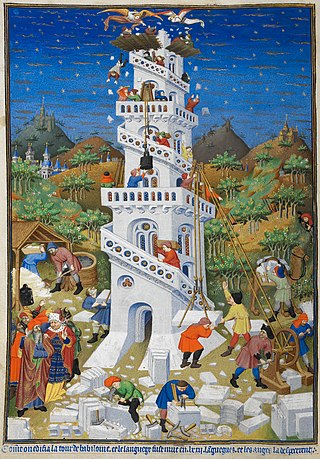
The Bedford Hours is a French late medieval book of hours. It dates to the early fifteenth century (c. 1410–30); some of its miniatures, including the portraits of the Duke and Duchess of Bedford, have been attributed to the Bedford Master and his workshop in Paris. The Duke and Duchess of Bedford gave the book to their nephew Henry VI in 1430. It is in the British Library, catalogued as Add MS 18850.
Anne Livingstone, Countess of Eglinton was a Scottish courtier and aristocrat, and lady-in-waiting to Princess Elizabeth and Anne of Denmark.

The Spinola Hours is a illuminated manuscript book of hours of about 1510-1520, consisting of 312 folios, over 80 of which are mainly decorated with miniature paintings. It was produced between Bruges and Ghent in Flanders around 1510-1520, and is a key work of the Ghent–Bruges school of illuminators. According to Thomas Kren, a former curator of the J. Paul Getty Museum, the miniatures within the Spinola Hours can be attributed to five distinct sources. Forty-seven of these illuminated pages can be attributed to the 'Master of James IV'. Since 1883 it has been in the J. Paul Getty Museum in Malibu, catalogued as Ms. Ludwig IX 18 (83.ML.114).
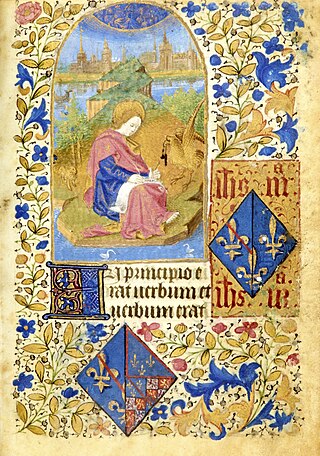
The book of hours of Joan of France is a 15th-century illuminated manuscript forming a book of hours, named after Joan of France, Duchess of Bourbon, who owned the book in the 15th century. After her death, it passed to Catherine of Armagnac, whose coat of arms was added to the book. After her death, the whereabouts of the book are unknown; it reappeared again in the late 19th century when it was bought by private collector Victor Martin Le Roy. It then passed to his son-in-law, art historian Jean-Joseph Marquet de Vasselot. It was again sold in 2011, and then bought by the Bibliothèque nationale de France, thanks to funding from private donors. It is classified as a national treasure of France. The rich decoration, including 28 full-page miniatures, was mostly made by the so-called Master of Jouvenel.
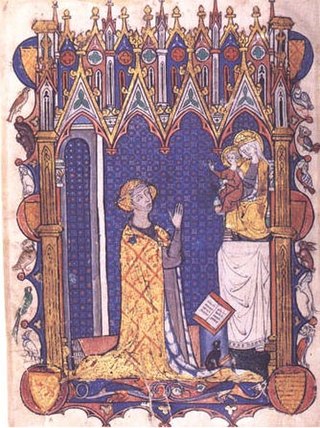
The Psalter–Hours of Yolande de Soissons is an illuminated manuscript produced in Amiens between about 1290 and 1297. It is currently kept at the Morgan Library in New York, accession number MS M.729.





















